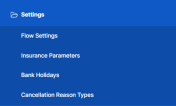Insurance Master
The Insurance Master solution is the foundation layer that controls major processes and configurations for different FintechOS end-to-end insurance solutions. It is a mandatory install in order to speed-up the automation and accurate execution of any of the FintechOS insurance solution that you use.
To view the details about the configurations that Insurance Master uses, go to your FintechOS Portal and click the main menu at the top left corner to open the drop-down. From the drop-down choose Settings.
Starting with the 2.5.0 release, the APIs used with Insurance Master are compatible with the OpenAPI v3.0 standard.
The menu for the digital frontend includes the following items:
| Display Name | Order Index | Digital Asset | Description |
|---|---|---|---|
| Flow Settings | 1 | Core Insurance Master | Displays the Flow Settings platform entity. Flow Settings must not be edited or deleted. |
| Insurance Parameters | 2 | Core Insurance Master | Displays the Insurance Parameter entity. Insurance Parameters can be edited. For details, consult the Insurance Parameters page. |
| Bank Holidays | 3 | Core Insurance Master | Displays the Bank Holiday entity. Bank Holidays can be added, edited or deleted. For details, consult the Bank Holidays page. |
| Cancellation Reason Types | 4 | Policy Admin Menu |
NOTE This menu item belongs to the Policy Admin module.
It displays the Cancellation Reason Type entity, belonging to the Policy Admin module. The Reason Type values can be added, edited or deleted. For details, consult the Cancellation Reason Types page. |
| Name | Description |
|---|---|
| InsuranceParameters | This Config Definition is used for importing new versions of insurance parameters. |
You can find them in the Configuration Data Definitions List, in FintechOS Studio.
The Data Import Templates allow you to add multiple types of data (insurance data, product data etc.) on a FintechOS destination environment. Data Import Templates also help a user to import only some very specific data about certain insurance product components - for example, a importing a list of insurable pet breeds, or a list of banks or exchange rates. Consequently, templates are different depending on what kind of data needs to be added.
Use Data Import Templates to import a product for the first time on a destination environment. However, for deploying changes on existing products or processes, use Data Config Definition (see above), as it has the versioning mechanism embedded.
The following are the templates used for data import:
|
Display Name |
Description |
|---|---|
| EntityFormSectionSecurityRole | |
| SystemUserSecurityRole | This template imports the relationship between security roles and system users. |
| Account Type | This template imports account types. |
| ActionXSecurityRole | This template imports the relationship between security roles and endpoints. |
| Security Role | This template is used to import the security roles |
| Pet Breed | A list of insurable pet breeds. |
| Bank | A list of banks is automatically imported with this digital asset. |
| BWrule SecurityRole | This template imports the relationship between security roles and business statuses. |
| CustomActionSecurityRole | This template imports the relationship between security roles and custom actions. |
| EntityFormSectionSecurityRole | This template imports the relationship between security roles and forms. |
| Exchange Rate | A list of exchange rate values is automatically imported with the digital asset. Don’t erase RON-RON or EUR-EUR combinations. |
| Exchange Rate Type | A list of exchange types is automatically imported with the digital asset. |
| Menu Item - Security Role | This template imports the relationship between security roles and menu items. |
| Security Role Item | This template imports the role items |
You can find them into the Data Import Templates List, in FintechOS Studio.
For more details, consult also the Data Import Templates the Data Config Definition, and the Configuration Data Package documentation.
The AccountCodeSequencer is the sequencer used to fill in the code attribute from the Account entity.
The FTOS_CLAIM_MainStyle is used for minimal styling.
